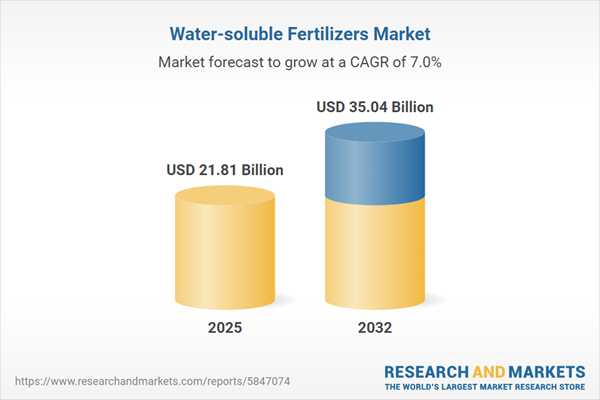Speak directly to the analyst to clarify any post sales queries you may have.
Water-soluble fertilizers stand at the forefront of modern agriculture, transforming nutrient management through precise, efficient, and environmentally responsible delivery. Their strategic significance extends across multiple crop types, supply chains, and regulatory landscapes, appealing to global agri-business leaders intent on advancing both productivity and sustainability.
Market Snapshot: Water-soluble Fertilizers Market Growth and Dynamics
The water-soluble fertilizers market grew from USD 20.46 billion in 2024 to USD 21.81 billion in 2025. It is expected to continue growing at a CAGR of 6.95%, reaching USD 35.04 billion by 2032. This robust upward trend highlights increased adoption in both emerging and established agricultural markets, spurred by precision farming, sustainability goals, and evolving global food demands. Senior executives and investors are advised to monitor technological advancements and policy developments that continue to define this dynamic market ecosystem.
Scope & Segmentation
This comprehensive report analyzes market dynamics across multiple dimensions, offering a nuanced understanding of market evolution. Segmentation covers:
- Type: Macronutrients (including nitrogen, phosphorus, potassium); Micronutrients (such as boron, copper, iron, manganese, molybdenum, and zinc); Secondary nutrients
- Product Type: Blended water-soluble fertilizers; Single nutrient fertilizers
- Formulation: Crystal, granular, liquid, powdered, and tablet/pellet forms
- Packaging Type: Bulk packaging; Small-scale packaging tailored for various operations
- Crop Type: Cereals and grains (barley, corn, rice, wheat); Fruits (apples, berries, citrus, grapes); Oilseeds and pulses (canola, soybean, sunflower); Turf and ornamentals; Vegetables
- Distribution Channel: Offline and online platforms, enabling direct-to-farm and retail procurement
- End-use: Agriculture, aquaculture, forestry, greenhouses and vertical farming, horticulture
- Region: Americas (North America, Latin America); Europe, Middle East & Africa; Asia-Pacific
- Companies Reviewed: Acron Group, Bayer AG, Brandt Inc., CF Industries Holdings, COMPO EXPERT, Coromandel International, EuroChem Group, Everris International, GrowGroup, GSFC, Haifa Negev technologies, Israel Chemicals, K+S, Kingenta, Kugler, MAPCO Fertilizer Industries, Nutrien Ag Solutions, OCP Group, Plant Food Company, Plant-Prod, ProPHOS Chemicals, SPIC, SQM S.A., Mosaic Company, Wilbur-Ellis Holdings, Yara International, Zuari Agro Chemicals, Neufarm GmbH
Key Takeaways: Strategic Insights for Senior Decision-Makers
- Water-soluble fertilizer adoption is accelerating due to integration with digital agriculture, supporting granular nutrient management and increased yields across diverse environments.
- Sustainability and resource efficiency are major market drivers, as precision application methods significantly curb nutrient runoff and optimize input use, aligning with global environmental policies.
- Manufacturers are leveraging controlled-release formulations and innovative blends, empowering growers to address specific crop and soil needs while adapting to variable climate conditions.
- Expansion of online distribution and customized packaging strengthens access for smaller enterprises and remote operations, democratizing modern fertilizer technologies.
- Public-private collaborations and investments in greenhouse, hydroponic, and vertical farming solutions are expanding application diversity and propelling regional market growth.
- Leading industry participants are focusing on R&D, digital tools, and acquisition strategies to maintain a competitive advantage as technology adoption deepens and customer expectations evolve.
Tariff Impact: Navigating Supply Chain and Pricing Adjustments
The imposition of US tariffs in 2025 has reshaped global sourcing, compelling industry players to diversify manufacturing bases and strengthen supply chain flexibility. These shifts have led to increased operational complexity, with strategic alliances and localized production emerging as preferred mitigation strategies. Pricing models now increasingly incorporate flexible terms and transparent risk-sharing, promoting resilient distributor-grower relationships and ensuring continuity despite geopolitical and regulatory pressures.
Methodology & Data Sources
Findings are drawn from rigorous primary and secondary research, comprising in-depth interviews with industry leaders and comprehensive reviews of literature, filings, and proprietary databases. Expert validation, triangulation, and use of analytical frameworks such as SWOT and PESTEL provide unbiased, actionable insights tailored for senior management.
Why This Report Matters
- Enables executive-level planning by clarifying technology trends, regulatory impacts, and competitive strategies shaping the water-soluble fertilizers landscape.
- Offers a segmented market view to support targeted product development and differentiated market entry or expansion strategies.
- Provides critical intelligence for risk mitigation and opportunity identification amid shifting policy and supply chain conditions.
Conclusion
Water-soluble fertilizers are redefining sustainable crop production and input management worldwide. This report equips industry stakeholders with the strategic clarity required to anticipate challenges and harness new growth avenues in a transforming global market.
Additional Product Information:
- Purchase of this report includes 1 year online access with quarterly updates.
- This report can be updated on request. Please contact our Customer Experience team using the Ask a Question widget on our website.
Table of Contents
3. Executive Summary
4. Market Overview
7. Cumulative Impact of Artificial Intelligence 2025
Companies Mentioned
The companies profiled in this Water-soluble Fertilizers market report include:- Acron Group
- Bayer AG
- Brandt, Inc.
- CF Industries Holdings, Inc.
- COMPO EXPERT GmbH
- Coromandel International Limited
- EuroChem Group
- Everris International B.V.
- GrowGroup
- Gujarat State Fertilizers & Chemicals Limited
- Haifa Negev technologies Ltd.
- Israel Chemicals Ltd.
- K+S Aktiengesellschaft
- Kingenta Ecological Engineering Group Co., Ltd.
- Kugler Company
- MAPCO Fertilizer Industries FZE
- Nutrien Ag Solutions, Inc.
- OCP Group
- Plant Food Company, Inc.
- Plant-Prod Inc.
- ProPHOS Chemicals S.r.l.
- Southern Petrochemical Industries Corporation (SPIC) Limited
- SQM S.A.
- The Mosaic Company
- Wilbur-Ellis Holdings, Inc.
- Yara International ASA
- Zuari Agro Chemicals Ltd.
- Neufarm GmbH
Table Information
| Report Attribute | Details |
|---|---|
| No. of Pages | 186 |
| Published | November 2025 |
| Forecast Period | 2025 - 2032 |
| Estimated Market Value ( USD | $ 21.81 Billion |
| Forecasted Market Value ( USD | $ 35.04 Billion |
| Compound Annual Growth Rate | 6.9% |
| Regions Covered | Global |
| No. of Companies Mentioned | 29 |









